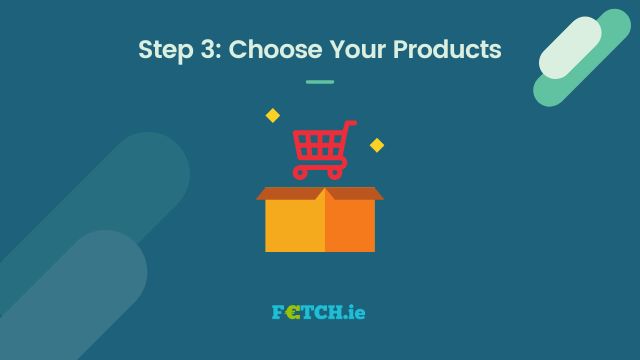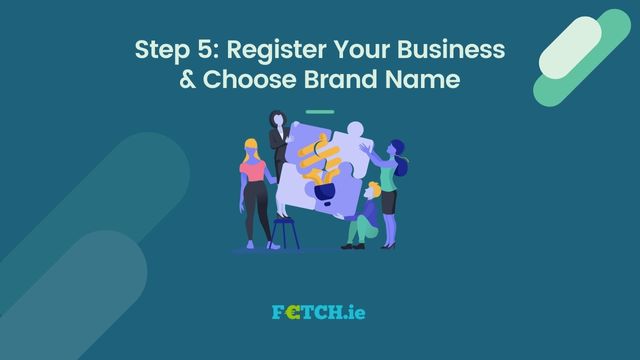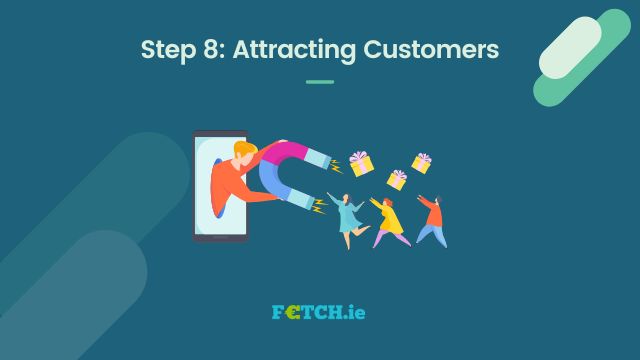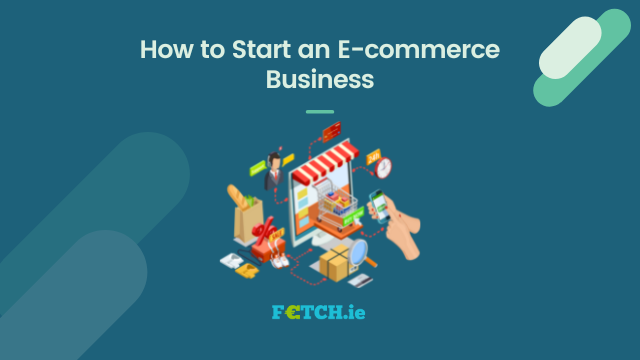What is an Ecommerce Business?
An e-commerce business is a business which buys and sells goods/ services over the internet. Their business will transfer money digitally to complete these transactions.
According to Statista, Online retail sales totalled 4.9 Trillion US Dollars worldwide. It is forecasted to grow by over 50% within the next four years. It’s a brilliant time to start in e-commerce now and feel the growth over the next few years.
It’s become more manageable for entrepreneurs and creatives to start their own e-commerce stores. They can now build their own business, giving a sense of freedom. You are your own boss.
We have outlined a few steps to take to start an e-commerce business today. Read on to get our recommendations and tips on starting and running a successful e-commerce business.
Steps to Starting an E-Commerce Business
- Step 1: Do your research on the e-commerce space
- Step 2: Undertake competitive research
- Step 3: Choose Your Products
- Step 4: Decide how you’ll get your product
- Step 5: Register Your Business & Choose Brand Name
- Step 6: Complete Your Business Plan
- Step 7:Create Your Online Store
- Step 8: Attracting Customers
How to Start an E-commerce Business
There are considerable differences between starting an e-commerce business compared to your traditional brick-and-mortar business. On the other hand, there are quite a few similarities too. We will discuss both below. You also need to factor in the legal requirements for setting up a business which we will guide you on. Once you plan, you will notice the differences between e-commerce and a physical store.
We know that online sales are increasing, but we’ve often seen many e-commerce businesses struggle to get traction or a large volume of sales. We know nothing is more rewarding than starting a business from the ground and watching it grow.
Starting an e-commerce business is more than simply choosing a brand name, taking lovely images and selling products online. Quite a lot goes into setting up a successful e-commerce store. Once you have it set up, you need to manage it correctly and constantly optimise your store.
Step 1: Do your research on the e-commerce space

Before looking at products or any branding, we advise you to do some e-commerce research. If you were looking at opening a barber shop, for example, you’d look at a location, a theme and so on. The same goes for e-commerce. You should research the e-commerce area you are interested in.
You’ll need to consider what your e-commerce business will offer customers. Think of your business model. Are you selling a physical product? Or will they be a digital product or service? Do you know where you’ll source your products?
Once you know how you’ll source your products, you’ll have to think logistics of how you’ll get your product/service to your customer. What costs will you incur to start up? Are there legal regulations for dealing with a product or service?
Asking questions like this is crucial to your business and will help you create a business plan. It will give you a better overall view of the business goals and how you will attain them. It is also essential to find your niche, especially in the e-commerce space.
There is a lot of competition in the e-commerce industry, so you need to stand out and perfrom in-depth competitive research. Find a unique space where your brand can stand out and find success in selling your product/services.
Step 2: Undertake competitive research

Once you have chosen your niche, find the top competitors in that particular e-commerce space. Research their business model, get product ideas and more. See what customers are looking for in your specific industry and think about how you can put a creative twist on it.
You’ll need to identify how you will enter that e-commerce industry. What challenges will you face, and how will you overcome them? Will you have to invest in ads? Will you need expensive equipment? Do you need high-quality graphics made? If you need any of these and don’t have the money for them, how will you work around the issue? It’s always best to start small when starting up an e-commerce business.
Identify any gaps in the industry and think of a handful of products. Don’t worry if you have a product that’s already out there. Try to provide it to your customer in a way nobody else is doing.
You should then conduct what is called a “SWOT ANALYSIS”. If any of you did business in school or college, you might have heard of it. SWOT stands for – Strengths, Weaknesses, Opportunities, and Threats. It can help you plan best for the future of your e-commerce business.
You can typically control Strengths and Weaknesses such as:
- Reputation
- Customer Base
- Brand Culture
- Intellectual Property
On the other hand, you may not be able to control Opportunities or Threats, but you can plan for them. They can include:
- Competitors
- Market Trends
- Economy
Step 3: Choose Your Products

One of the first real steps to building your e-commerce store is to know what products to sell to your customer. It may be one of the most challenging parts. Many e-commerce store owners may know what products to sell, which is why they want to set up a store. We will help you search for products, where to find them and how to spot trends.
Think about personal experience. Have you worked in an industry that has given you insights that others may not have?
Have you found a product that users will need based on a trend in your industry? If you can recognise these trends, you can become a market leader early on.
There are multiple ways to spot trends. They include:
- Social Media: Check out parts of social media where peers in your industry are talking. See where your target customers spend their time. Browse trending hashtags or use social listening tools to gain interesting and valuable insights.
- Follow Search Trends: Using Google Trends, you can see what products people are searching for online. You can also tell what keywords are commonly searched for, and more fascinating, you can identify what problems users are searching for and use this to find a solution.
Check out reviews of similar products to yours and see what customers say. If something is lacking, make a note of it and see if you can improve on that existing product. If you can identify and explore an unmet customer need, then you’re already standing yourself out in a crowded market.
Find Your Target Market
You now have a solid product that you want to sell online. Who is your ideal customer to sell to? Are there specific characteristics associated with them? Customer personas can be highly beneficial to get a sense of who your perfect customer is.
You can create a persona based on how best your product/ service would serve that customer and how it would appeal to that individual.
Ask yourself many questions such as:
- How old is the customer?
- Where do they live?
- What are their interests?
- What’s their job?
By reflecting on your answers, you can tell if they’re likely to be online or not. If not, then this product/service is not for you. If it is, then fantastic that information will help you launch and market your e-commerce store.
Step 4: Decide how you’ll get your product
When selling a physical product, you’ll need to find a business model to get it and then ship it to customers. There are certain models you can look at following.

Make it
This model is what it sounds like. You will make the product by hand and get it to the customer. We often see this model with creatives making soaps, woodwork designs and pottery. You will have to purchase the ingredients in small batches, and at the start, profits will not be significant. If you feel you’re growing, then it’s time to scale up the production.
Manufacture it
If you have an idea for a product but can’t make it yourself, then you could look at partnering with a manufacturer. Typically you will have to order large amounts in bulk, so you’ll need to be able to cover the costs and believe that your product will sell.
Dropship it
We have covered dropshipping before, but it involves you partnering with a company that would ship the products for you after someone orders off your store. There is no cost associated with this model, only the cost of your site and possibly ads. Your profit margin is only about 20%, but you’re not doing any of the heavy lifting. You simply list the product on your e-commerce store, and your drop shipping partner will provide it for you.
Sell it Digitally
Here you only sell digital products/ services such as online courses, resources, and anything people can download online.
Digital downloads are very convenient for customers. They usually have a low overhead too, which is fantastic. Starting your business with digital products is a great option. You shouldn’t be afraid to experiment with a few different products.
Step 5: Register Your Business & Choose Brand Name

So you’ve thought about products and your customer personas. You need to start a brand that connects with those customer personas. If your service targets professional businesswomen, you may want to avoid the classic girlie colours and stereotypes. Create a brand specifically for them and how you think they’d like to feel. Before planning too far ahead, there are some legal steps you must take.
Register Your Business
You must register your business name in Ireland with the CRO. This is a legal requirement, so do not skip it.
Choose your Store Name
Your business name and store name don’t need to be identical, but we would always recommend keeping your names consistent if you can. Ensure that your name fits in with your niche, as you don’t want to be changing it down the road.
Get help from a Local Enterprise Office (LEOs)
Your Local Enterprise Office offers a wide range of financial support depending on your business needs. It could be a great help in getting your e-commerce store up and running.
Create a Logo
Logos are essential for the branding of your business. It doesn’t have to be unique, but it should fit in with your brand and your niche. Ensure you don’t use the same as another company in your niche.
Get Your Visuals in Line
Get a colour palette for your brand that you use across your website, social and any other marketing efforts. You should also have a specific typeface you use across all channels and graphics. If you can hire or outsource this work to a marketing team, then we recommend doing so. If not, then create your own. There are many tools out there to help you, with Canva being an excellent tool for creating visuals.
Step 6: Complete Your Business Plan

At this stage, you should know most of what your business will look like and how it will run. You’ve decided on a niche, a product and a business name.
It’s time to get pen to paper and write your business plan. It will help you determine any startup costs, loans and monthly expenses. It will help you plan out all the financials involved in starting your e-commerce store.
Manage Your Financials
The main aim of the business is financial. You need to think about how many products you need to sell to break even. Work out your profit margin, or else you won’t know how to accurately predict how much money is going in and out.
The business plan will help fine-tune any details such as staff, sourcing products, shipping and marketing budget. There is help in Ireland if you need help with your business plan or finances.
Manage Your Inventory
If you decide to sell physical products, you’ll need somewhere to store your inventory. You can utilise fulfilment centres or rent a warehouse. If you are starting small, you can use your shed until you scale up.
Inventory management software will be crucial in keeping your business organised. If you’re starting small, you won’t need it until you scale up.
You need to have a solid strategy to succeed in your e-commerce store.
Step 7:Create Your Online Store

It’s finally time to set up your e-commerce store. You will need to register your domain name. Using the info you gathered on your brand planning earlier, it’s time to create and build your store.
There is an endless list of e-commerce platforms available on the market. Choosing the right platform for you can be tricky. You’ll need to consider aspects such as features, payment compatibility, SEO features, your web developer skills and much more. We take a look at some of the best options below.
E-Commerce Platforms
Check out a few of our favourite e-commerce platforms below.
Shopify
Shopify is a full commerce platform. It allows you to start, grow and manage a business. Shopify integrates all areas of commerce into one simple platform.
Using Shopify merchants can build and customise their online store and sell in multiple places such as online, phone, in person, in physical stores and across social media.
Pros
- Fast loading and easy to use
- Brilliant for a dropshipping business
- Attractive-looking templates and fully responsive for mobile
- Built-in email marketing
Cons
- SEO performance is not the best
- Can’t customise the checkout
- Apps can be expensive
- Transaction fees on the “Starter” plan are quite high at 5%
BigCommerce
BigCommerce is one of the top e-commerce platforms. It offers a fantastic choice of features, applications and integrations. The benefit of BigCommerce is how customisable it is while being very secure.
BigCommerce is ideal for that looking to shift an offline business online or to help those planning to scale their business online.
Pros
- Strong SEO Performance
- Selling in multiple currencies is very simple
- There are no transaction fees
- Built-in product review functionality
Cons
- Free themes are very similar to each other
- Page builder doesn’t let you use custom fonts
- Not as easy to edit the free template
Squarespace
Squarespace is the ideal platform for creative websites and e-commerce stores. You can create stunning and aesthetic e-commerce stores on Squarespace, unlike other e-commerce platforms.
On Squarepsace you can not only sell products online but you can also allow customers to book your services. Schedule appointments with online bookings and calendars.
Pros
- Beautifully designed templates
- Excellent user interface
- No transaction fees to worry about
- Lots of typefaces to work with
Cons
- They have no multi-currency selling functionality
- Payment gateways are limited
- Their sites could load quicker
- GDPR compliance is poor in cookie consent
Step 8: Attracting Customers

Once you set up your e-commerce store, there is no guarantee that users will visit it.
SEO is going to be vital to driving traffic to your website. SEO stands for Search Engine Optimisation. You will need to keep keywords in mind on each page you create on your website.
Online marketing is essential for an e-commerce store. If you don’t have the budget to invest, then you can task yourself with your marketing efforts. Do this by reading articles, taking courses and listening to podcasts.
Your Marketing Focus
There are many areas of marketing to focus on for e-commerce. The aim is to not only focus on one. Some areas to look at investing time and resources in are:
- Paid Ads
- Paid Social Ads
- Sponsored Content
- Influencer Marketing
- Affiliate Marketing
Your first port of call should be to create an email list. Typically e-commerce stores may offer 10% off your next purchase if you subscribe to their newsletter. We would recommend doing this. These are customers interested in your products which are willign to buy from you. Send a weekly, fortnightly or monthly email about products, discounts and more and see how it helps your sales.
Another fantastic method to get quick traffic and subscribers is by running a giveaway. They have the added benefit of increasing your brand presence online and product visibility. It can be a great way to get others to share your business on social media and gain valuable followers.
Time to start your e-commerce business
We have covered everything you’ll need to start an e-commerce business. We hope this post helped answer any questions you had about starting an e-commerce store. Give it a share online if you enjoyed it. Good luck with your e-commerce startup, and be sure to let us know how you progress over the coming months.



